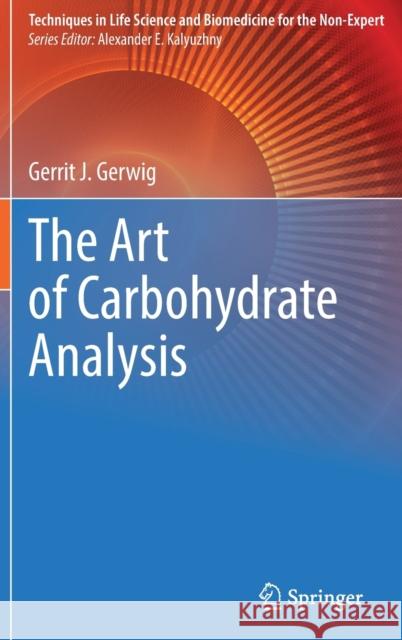The Art of Carbohydrate Analysis » książka



The Art of Carbohydrate Analysis
ISBN-13: 9783030777906 / Angielski / Twarda / 2021 / 350 str.
The Art of Carbohydrate Analysis
ISBN-13: 9783030777906 / Angielski / Twarda / 2021 / 350 str.
(netto: 325,85 VAT: 5%)
Najniższa cena z 30 dni: 327,68
ok. 22 dni roboczych.
Darmowa dostawa!
Wydanie ilustrowane
List of abbreviations
Preface
Introduction
Chapter 1 The World of Carbohydrates
Chapter 2 Basic Knowledge of Glycobiology
2.1 Monosaccharides
2.1.1 The Molecular Structure
2.1.2 D/L-forms of Monosaccharides2.1.3 Specific Monosaccharides
2.2 Oligosaccharides2.3 Polysaccharides
2.4 Glycoconjugates
2.4.1 Glycoproteins
2.4.1.1 N-glycans
2.4.1.2 O-glycans
2.4.1.3 Blood Group Determinants
2.4.1.4 Different Types of Glycosylation
2.4.1.5 Glycosides
2.4.2 Proteoglycans and Glycosaminoglycans
2.4.3 Glycolipids
2.4.4 Glycosylphosphatidyl-inositol Membrane Anchors
2.5 Intrinsic Complexity of Carbohydrates
2.6 Working in a Laboratory
Chapter 3 Carbohydrates involved in Diseases
Chapter 4 Detection of Carbohydrate by Colorimetric Methods
4.1 Introduction
4.2 Preparing Standard Sugar Solutions for Calibration Curves
4.3 General tests4.3.1 Detection of Carbohydrate by a Spot Test
4.3.2 Phenol-Sulfuric Acid Assay
4.3.3 Anthrone Test4.3.4 Molisch’s Test
4.3.5 Fehling’s Test
4.3.6 Benedict’s Test4.3.7 Barfoed’s Test
4.4 Specific Tests
4.4.1 Seliwanoff’s Test for Ketoses4.4.2 Bial’s Test for Pentoses
4.4.3 Colorimetric Analysis of (N-acetyl) Aminosugars
4.4.4 Colorimetric Analysis of Uronic Acids
4.4.5 Colorimetric Analysis of Sialic Acids
4.4.6 Iodine Test for Starch
Chapter 5. Analytical Techniques to Study Carbohydrates
5.1 Structural Parameters5.2 Glycosidic-bond Cleavage techniques
5.2.1 Sulfuric Acid Hydrolysis
5.2.2 Hydrochloric Acid Hydrolysis
5.2.3 Trifluoroacetic Acid Hydrolysis
5.2.4 Methanolysis
5.2.5 Formolysis
5.2.6 Acetolysis5.2.7 Specific Degradations
5.3 Common Separation Techniques for Mono/Oligosaccharides5.3.1 Thin-Layer Chromatography
5.3.2 Size-Exclusion Chromatography5.3.3 High-Performance Liquid Chromatography
5.3.4 Porous Graphitized Carbon Chromatography5.3.5 Anion/Cation-Exchange Chromatography
5.3.6 High-pH Anion-Exchange Chromatography5.3.7 Affinity Chromatography
5.4 Detection Techniques for Liquid Chromatography5.4.1 Detectors
5.4.2 Labeling of Glycans for Detection
5.4.2.1 Labeling by Reductive Amination
5.4.2.2 Labeling by Michael Addition with PMP
5.4.2.3 Permethylation of Glycans for Mass Spectrometry
5.5 Electrophoretic Separation of Carbohydrates
5.6 Gas-Liquid Chromatography
Chapter 6 Monosaccharide Composition Analysis
6.1 Introduction
6.2 Gas-chromatographic Monosaccharide Analysis using TMS Methyl Glycosides
6.3 Gas-chromatographic Monosaccharide Analysis using Alditol Acetates
6.4 Determination of D/L Configuration of Monosaccharides
6.5 Monosaccharide Analysis by HPLC Methods 6.5.1 High-pH Anion-Exchange Chromatography
6.5.2 Ultra-High-Performance Liquid Chromatography
6.6 Determination of Carbohydrate Linkages by Methylation Analysis6.6.1 Chemical Aspects
6.6.2 GLC-EI Mass Spectrometry of PMAAs6.6.3 Glycosidic Linkage Determination by HPLC-MS/MS
Chapter 7 Carbohydrate Analysis of Glycoconjugates
7.1 Introduction
7.2 Analysis of Glycoproteins7.2.1 A Typical Approach to the Analysis of a Glycoprotein
7.2.2 Chemical Release of N- and O-linked Glycans7.2.3 Enzymatic Release of N-linked Glycans
7.2.3.1 Isolation of N-glycans and de-N-glycosylated
protein (containing O-glycans)
7.2.4 Release of O-glycans by Reductive β-elimination
7.3 Analysis of Glycopeptides
7.3.1 Preparation of Glycopeptides from Glycoproteins7.3.2 Separation of Glycopeptides
7.4 Analysis of Proteoglycans and their Glycosaminoglycans7.5 Analysis of Glycolipids
7.5.1 General Aspects
7.5.2 Thin-Layer Chromatography of Glycolipids
7.5.3 Carbohydrates of Glyco(sphingo)lipids
7.5.4 Carbohydrates of Glycosylphosphatidylinositol (GPI) Anchors
7.6 Analysis of Polysaccharides
Chapter 8 Structural Characterization of Released Glycans
8.1 Introduction
8.2 Analysis of N-glycans
8.2.1 Fractionation of N-glycans8.2.2 Preparation of Glucose Oligomers Standard (Dextran-ladder)
8.2.3 Enzymatic Sequence Analysis of N-glycans8.3 Analysis of O-glycans
8.3.1 General Aspects
8.3.2 Mucin Glycoproteins
8.3.3 Fractionation of O-glycans
Chapter 9 Analysis of Sialic Acids
9.1 General Aspects
9.2 Characterization of Sialic Acid Residues9.2.1 Colorimetric Determination
9.2.2 Gas-chromatographic Determination9.2.3 Release of Sialic Acids by Mild Acid Hydrolysis
9.2.4 Analysis of DMB-labeled Sialic Acid9.2.5 Release of Sialic Acids by Enzymatic Digestion
9.3 Mass Spectrometry of Sialic Acids9.4 1H NMR Spectroscopy of Sialic Acids
Chapter 10 Carbohydrate Microarray Technology
Chapter 11 Analysis of Carbohydrates by Mass Spectrometry
11.1 General Aspects
11.2 Electron Impact Mass Spectrometry (EI-MS)
11.3 Mass Spectrometry of Glycans
11.3.1 General
11.3.2 Matrix-Assisted Laser Desorption/ionization-Time of Flight mass
spectrometry (MALDI-TOF-MS)
11.3.3 Electrospray Ionization-Mass Spectrometry (ESI-MS)
11.3.4 Tandem Mass Spectrometry
11.3.5 Mass Fragmentation of Oligosaccharides
Chapter 12 Analysis of Carbohydrates by Nuclear Magnetic
Resonance Spectroscopy
12.1 Introduction
12.2 Principle of NMR Spectroscopy
12.3 NMR Spectroscopy of Carbohydrates
12.3.1 Sample Preparation and Measuring
12.3.2 1H NMR Structural-Reporter-Group Concept
12.3.3 13C NMR Spectroscopy
12.4 NMR Spectroscopy for Glycans
12.4.1 Two-dimensional NMR Spectroscopy
12.4.2 Spectral Interpretation and Assignments
12.5 NMR Spectroscopy of Polysaccharides
12.5.1 Summarized NMR Measuring Procedure
Chapter 13 Glycobioinformatics
Chapter 14 Concluding Remarks
Appendix A EI-MS of partially methylated alditol acetates (PMAAs)
Appendix B MALDI-TOF-MS of permethylated N-glycans
Appendix C ES-MS [M-H]- signals of some O-glycans (as alditols)
Glossary of terms
ACKNOWLEDGMENTS
DISCLAIMER
REFERENCES
Subject Index
The growing importance of glycobiology and carbohydrate chemistry in modern biotechnology and the pharmaceutical industry makes accurate carbohydrate analysis indispensable. This book provides the principles and protocols of various fundamental carbohydrate analysis methods. Choice of method is entirely dependent upon the type of material being investigated (biological samples, food products, etc.), and the level of structural detail required, i.e. sugar content, compositional analysis, linkages between the sugar components, or the total chemical structure of a given molecule. Full structural characterization of carbohydrate chains requires significant time, resources, and skill in several methods of analysis; no single technique can address all glycan analysis needs.
1997-2026 DolnySlask.com Agencja Internetowa
KrainaKsiazek.PL - Księgarnia Internetowa









